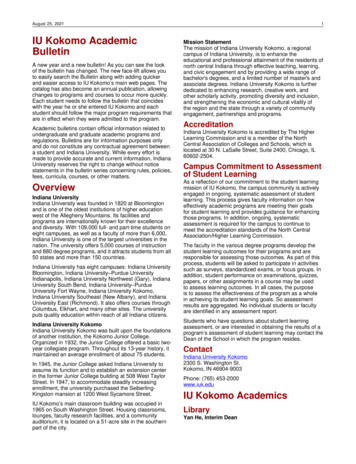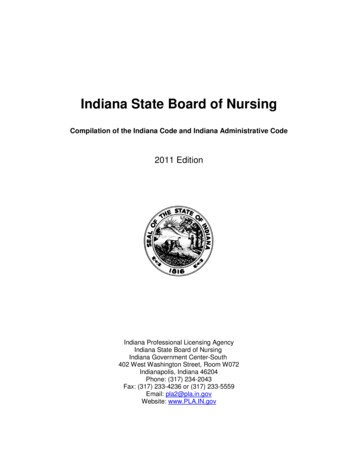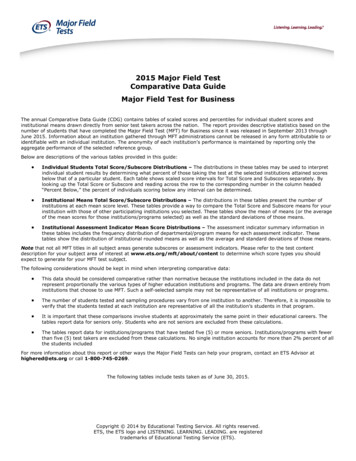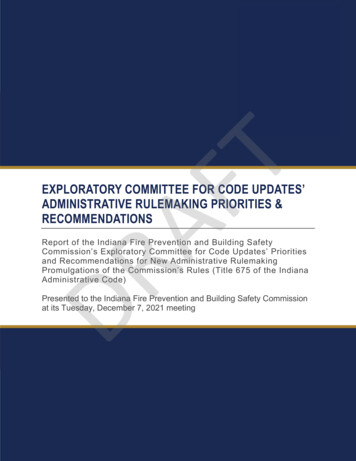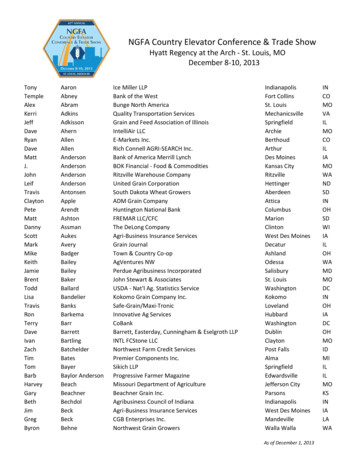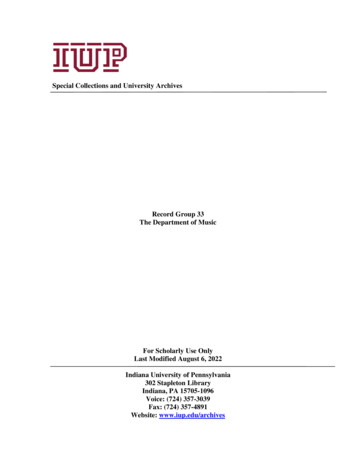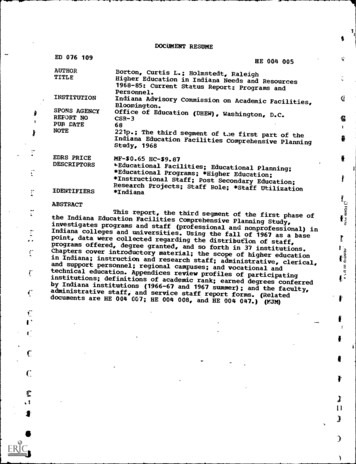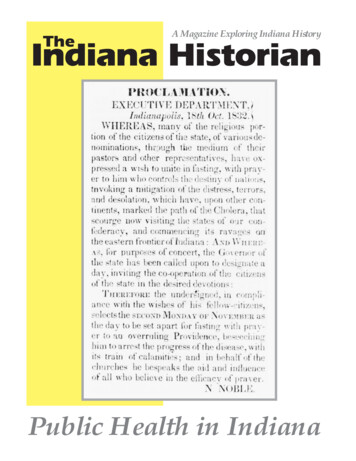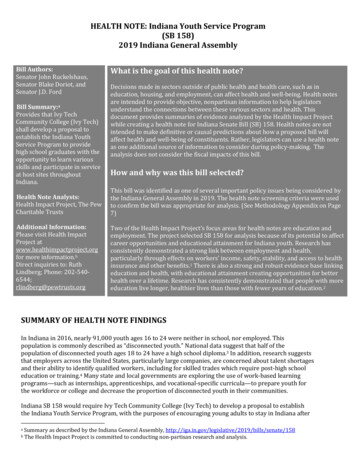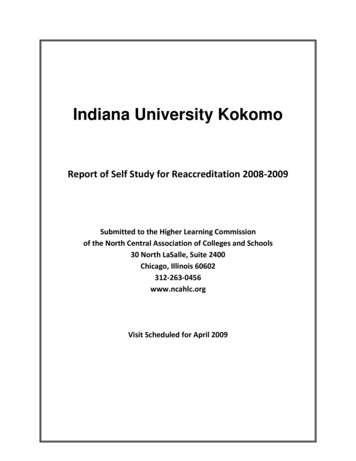
Transcription
Indiana University KokomoReport of Self Study for Reaccreditation 2008-2009Submitted to the Higher Learning Commissionof the North Central Association of Colleges and Schools30 North LaSalle, Suite 2400Chicago, Illinois 60602312-263-0456www.ncahlc.orgVisit Scheduled for April 2009
AcknowledgmentsDeveloping an institutional self study involves the work of many people. Appreciation goes toall the faculty, staff, students, and friends of the campus for their contributions to this project.Many of these individuals attended the campus convocations and open forums to ensure thatall voices helped identify the campus strengths and challenges. Particular thanks go to bothChancellor Ruth Person for her leadership at the beginning stages of the process and toChancellor Stuart Green for his support throughout the process and his careful reading of thedraft documents.The leaders of the five criterion committees deserve special thanks for all of their work ingathering, organizing and evaluating the evidence needed to complete Good to Great. Specialacknowledgements go to these leaders: Linda Wallace and Kathy Parkison (Criterion One); CarlPennington and John Stachacz (Criterion Two); Sharon Calhoon (Criterion Three); ChristianChauret (Criterion Four); and Niranjan Pati and Shirley Aamidor (Criterion Five). The names ofthe criterion committee members are listed in Appendix C.Ann Cameron deserves special note for her tireless efforts to edit and finalize the document.Kirsten Leonard coordinated the resource room and creatively found a solution to the websitelink problem caused by the transition from the old to the new webpage. The formatting andpreparation of the printer-ready copy was the work of Scott Manthe. Meg Ban, of IU Kokomo’sOffice of Marketing and Communications, designed the self-study cover. Finally, thanks go tothe individuals who coordinated the logistics of the team visit: Marsha Shaw, Kathy Coppola,Cathy Archer, Anna Aichele, and Tara Halbrook.2
Table of ContentsAcknowledgments 2Table of Contents 3Glossary of Acronyms 7Introduction 11Background 11The Self-Study Process at Indiana University Kokomo 12Institutional Structure and Governance 13Significant Developments at IU Kokomo 1998-2008 14Changes in Leadership 15Refinement of Mission 16Accreditations 17New Programs 17Facilities 17Addressing the Challenges Identified by the 1999 Visiting Team 19Chapter 1: Mission and Integrity 31Core Component 1a 32The organization’s mission documents are clear and articulate publicly the organization’scommitments.Core Component 1b 39In its mission documents, the organization recognizes the diversity of its learners,other constituencies, and the greater society it serves.Core Component 1c 47Understanding of and support for the mission pervade the organization.Core Component 1d 53The organization’s governance and administrative structures promote effective leadership andsupport collaborative processes that enable the organization to fulfill its mission.Core Component 1e 65The organization upholds and protects its integrity.3
Chapter 2: Preparing for the Future 75Core Component 2a 75The organization realistically prepares for a future shaped by multiple societal and economictrends.Core Component 2b 88The organization’s resource base supports its educational programs and its plans formaintaining and strengthening their quality in the future.Core Component 2c 106The organization’s ongoing evaluation and assessment processes provide reliable evidence ofinstitutional effectiveness that clearly informs strategies for continuous improvement.Core Component 2d 110All levels of planning align with the organization’s mission, thereby enhancing its capacityto fulfill that mission.Chapter 3: Student Learning and Effective Teaching 115Core Component 3a 116The organization’s goals for student learning outcomes are clearly stated for each educationalprogram and make effective assessment possible.Core Component 3b 123The organization values and supports effective teaching.Core Component 3c 129The organization creates effective learning environments.Core Component 3d 147The organization’’s learning resources support student learning and effective teaching.Chapter 4: Acquisition, Discovery, and Application of Knowledge 157Core Component 4a 158The organization demonstrates, through the action of its board, administrators, students,faculty, and staff, that it values a life of learning.Core Component 4b 170The organization demonstrates that acquisition of a breadth of knowledge and skills andthe exercsie of intellectual inquiry are integral to its educational programs.Core Component 4c 177The organization assesses the usefulness of its curricula to students who will live and work ina global, diverse, and technological society.Core Component 4d 186The organization provides support to ensure that faculty, students, and staff acquire, discover,and apply knowledge responsibly.Chapter 5: Engagement and Service 195Core Component 5a 195The organization learns from the constituencies it serves and analyzes its capacity to servetheir needs and expectations.4
Core Component 5b 200The organization has the capacity and the commitment to engage with its identifiedconstituencies and communities.Core Component 5c 207The organization demonstrates its responsiveness to those constituencies that dependon it for service.Core Component 5d 214Internal and external constituencies value the services the organization provides.Conclusion: Summary of Findings and Request for Reaccreditation 221Appendix A: Organizational Charts 229Appendix B: Federal Compliance 239Appendix C: Self-Study Steering Committee and Subcommittees 243Appendix D: Institutional Snapshot 2475
6
Glossary of LabD:EDHHSDPSEEOEMAEOBEPCETSAmerican Association of Colleges of NursingAmerican Association of Collegiate Registrars and Admissions OfficersAssociation to Advance Collegiate Schools of BusinessAdvance College ProjectAmericans with Disabilities ActAmerican Democracy ProjectACCELerated Evening CollegeArchives of Institutional MemoryAssociate of Science in NursingBachelor of ArtsBachelor of General StudiesBachelor of ScienceBachelor of Science in NursingCommunity Alliances to Promote EducationCommission on Collegiate Nursing EducationChief Executive OfficerChief Financial OfficerChief Information OfficerComputer Information SystemsCollege Management ProgramCenter for Research and Creative ActivityCommitment to Teaching ExcellenceCenter for Teaching, Learning, and AssessmentCurriculum Lab/Teacher Resource CenterDestination: EducationDepartment of Health and Human ServicesDivision of Professional StandardsEqual Employment OpportunityEnhancing Minority AttainmentEarly Outreach BuildingEducational Policies CommitteeEducational Testing Service7
UIU KokomoIUPUIIU South lty Colloquium on Excellence in TeachingFinancial Accounting Standards BoardFamily Educational Rights and Privacy ActFiscal Operations Report and Application to ParticipateFreshman Learning CommunityFair Labor Standards ActFamily Medical Leave ActFull-timeFull-time EquivalentFiscal YearFederal Wide AssuranceGraduate Affairs CommitteeGovernmental Accounting Standards BoardHistorically Black Colleges and UniversitiesHigher Education Research InstituteHigher Learning CommissionHuman ResourcesHoward Regional Health System—Behavioral Health ServicesInstitutional Animal Care and Use CommitteeIndiana Commission for Higher EducationInterstate New Teacher Assessment and Support ConsortiumIndiana Project on Academic SuccessIntegrated Postsecondary Education Data SystemInstitutional ResearchInstitutional Review BoardInformation TechnologyIndiana UniversityIndiana University KokomoIndiana University Purdue University IndianapolisIndiana University South BendJoint Review Committee on Education in Radiologic TechnologyLearning Enhancement CenterMaster in Business AdministrationMission Differentiation ProjectMaster in Liberal StudiesMaster of Public AffairsMaster of Public ManagementNational Academic Advising Association8
PIRAURSIVISIONVSAWCWAWIREDNational Association of College and University Business OfficersNational Board for Professional Teaching StandardsNorth Central AssociationNational Collegiate Athletic AssociationNational Council for Accreditation of Teacher EducationDepartment of Natural, Information, and Mathematical SciencesNational Survey of Student EngagementOffice of Communication and MarketingOffice of Management and BudgetPart-timeResearch Integrity OfficerRegistered NurseRepair and RenovationSmall Business Development CenterDepartment of Social and Behavioral SciencesSchool of Continuing StudiesStudents in Free EnterpriseStudent Information SystemsSchool of Arts and SciencesScholarship of Teaching and LearningSchool of Public and Environmental AffairsTeam-Based LearningTake Back the NightTeacher Education CommitteeUniversity Budget OfficeUniversity Faculty CouncilUniversity Information Technology ServicesUniversity Planning, Institutional Research, and AccountabilityUndergraduate Research Summer InstituteVision of Industries and Schools in Ongoing NetworksVoluntary System of AccountabilityWildcat Creek Watershed AllianceWorkforce Innovation in Regional Economic Development9
10
IntroductionBackgroundIn 1945, near the end of World War II, Indiana University established an extension center in astately Victorian home at 508 W. Taylor Street in Kokomo that had served as Kokomo JuniorCollege. Educator Virgil Hunt was called upon to open the new school, and in a 1995 interviewhe recalled his legendary first day on the campus on West Taylor Street: “When I got toKokomo, it was really dark. I found 508 W. Taylor and located a window open. I crawled inthrough that window and spent the night on the sofa.” This story recounts the humblebeginnings of IU Kokomo from its days as a small, one-building campus being formed from theground up by a dedicated individual. In the sixty-plus years since that day, the campus movedto its current location on Washington Street, added five buildings, increased the numbers of itsfaculty and student body, developed a wide range of degree programs, and became one of theregional campuses of Indiana University.The front cover of this self-study report, a picture of Indiana University Kokomo’s newestbuilding, Hunt Hall, is a tribute to the legacy of Virgil Hunt, the founding director of the campus.This building, with its soaring, light-filled atrium, illuminates the journey the campus hastransformed from the small campus on Taylor Street under the reins of Virgil Hunt into amature regional resource with an award-winning science building named for him. “I see nothingbut greatness” for IU Kokomo, said Virgil, looking back to the campus’s modest beginnings.In the years following World War II, the Indiana University extension centers grew to meet theneed for postsecondary education throughout the state. Their primary purpose was to offergeneral education courses that students could transfer to Indiana University Bloomington orelsewhere in order to complete requirements for a baccalaureate degree. By the late 1960s, theextension centers had evolved into IU regional campuses with broader missions. The Kokomocampus offered associate and bachelor’s degrees. As part of its evolution, each campus movedtoward accreditation by the North Central Association of Colleges and Schools, separate fromthe Bloomington campus. Indiana University Kokomo is proudly now one of eight campuses ofIndiana University.IU Kokomo was first accredited in 1969 and had subsequent visits at five-year intervals. As aresult of the self study in 1988-89, the campus received ten-year accreditation for the first time.In September 1992, the campus had a focus team visit as a result of a request to change its11
statement of affiliation status in order to offer a Master of Business Administration degree. In1998, the campus again received ten-year accreditation.As the campus was preparing to begin the self-study process to request renewed accreditationfor a ten-year period, Chancellor Ruth Person introduced the book Good to Great by Jim Collinsto the campus leadership. Since the campus was undergoing yet another evolution in itsdevelopment, it seemed appropriate to place the journey in the context of moving from goodto great. In response to the introduction of a community college system in Indiana and a changein its mission, the campus is developing into a more mature baccalaureate institution withlimited graduate degrees. Jim Collins suggests that “Good is the enemy of great.” He arguesthat the vast majority of organizations never become great because it is just so easy to settlefor being good. The chancellor used the book as a framework for campus discussions on howthe campus could realize its vision statement, “Indiana University Kokomo aspires to become aregional institution of first choice.” The book led the campus faculty and staff to begin todiscern the hallmarks of the campus and the factors that distinguish its identity as a primarilybaccalaureate institution. The discussions have been lively, and the goal is that the campus willreach consensus on how to move forward toward this goal at the close of this academic year.The campus has used the occasion of preparing this self study to examine the changingenvironment in which IU Kokomo operates and its ongoing programs and activities. This finalreport serves as a vehicle to acquaint the members of the visiting team with IU Kokomo and tosummarize the campus’s strengths and efforts to address its challenges.The Self-Study Process at Indiana University KokomoA steering committee appointed by Chancellor Ruth Person and chaired by Dean Susan SciameGiesecke and Vice Chancellor Tim Sehr guided the writing of this report. Faculty, academicadministration, staff, and students were represented on the steering committee. Thecommittee created five subcommittees, one for each of the five criteria. Each subcommitteewas chaired by a member of the steering committee. A list of the steering committee andsubcommittee members can be found in Appendix C. To understand and prepare to supervisethe self-study process, the steering committee members attended the Higher LearningCommission Meeting in Chicago with Chancellor Person in both 2007 and 2008.Even before the formal self-study process began, the campus began to prepare for its self studyby inviting its former HCL liaison to speak at a convocation on campus regarding the newcriteria for accreditation. In addition, the deans of the schools and divisions at IU Kokomoreported to the campus as a whole on the status of engagement projects. To help the campusunderstand and prepare for the self-study undertaking, steering committee members andmembers of the administration discussed the self-study process at the 2007 and 2008 fall andspring campus convocations and at the 2009 spring convocation. The committees wereintroduced, and the campus faculty and staff were informed about the process and the criteria.The steering committee and the subcommittees met throughout the fall of 2007 and during thespring and summer of 2008 to draft each chapter. Draft chapters were analyzed in August bythe steering committee for comment, correction, and revision. Members of the chancellor’s12
Cabinet, Administrative Council, Deans Council, Academic Council, and the Faculty Senate alsoreviewed drafts and provided feedback on the report during the fall 2008 semester. Electroniccopies of the report were given to each department in early 2009 with printed copies placed inthe IU Kokomo Library. Student leaders also received a copy of the report. A final version of thereport was shared with the Faculty Senate and with the IU Kokomo Board of Advisors at theirJanuary meetings. All campus constituencies also received six issues of the Good to GreatNewsletter, which outlined the highlights of the report.The five criteria for accreditation guided the organization of the self-study report. Thisintroduction outlines the relationship between IU Kokomo and Indiana University, brieflysummarizes major changes that have occurred at IU Kokomo since the last comprehensive visit,and responds to the concerns of the 1998-1999 visiting team. Subsequent chapters addresseach criterion for accreditation in order. The final chapter summarizes the conclusions drawnby the campus as a result of the self-study process. The appendices provide organizationalcharts of campus administrative offices, information on federal compliance by the campus, alisting of the committee members involved in drafting this document, and the requiredinstitutional profile.Note: The IU Kokomo campus is currently undergoing a total revision of its website. Thisdocument contains links to IU Kokomo webpages that existed under the previous website.These links will remain useable as legacy links to provide information for the visiting team. Allexternal websites, including those active within Indiana University as a whole, will remaincurrent. The campus is also providing AIM (Archives of Institutional Memory) sites that willprovide searchable lists of a wide range of archived documents. In addition to the legacy andcurrent links provided in the document, a section on resources is supplied at the end of eachcriterion to provide information about access to documents relevant to each chapter. As soonas the links to the new website are made permanent, the campus will provide an updatedelectronic version of this self-study document for all members of the visiting team.Institutional Structure and GovernanceIndiana University was founded in 1820 in Bloomington, Indiana, and is one of the oldestinstitutions of higher education west of the Allegheny Mountains. Its facilities and programs areinternationally known for their excellence and diversity. With 99,000 full- and part-timestudents on eight campuses, as well as a faculty of more than 5,000, Indiana University is one ofthe largest universities in the nation. The university offers 5,000 courses of instruction and 880degree programs, and it attracts students from all 50 states and more than 150 countries. IUKokomo shares the central administrative structure with the other campuses of IndianaUniversity. Administrative leadership is provided by the president of Indiana University, anexecutive vice president, seven vice presidents, and, for seven of the eight campuses, achancellor. Indiana University is governed by a nine-member board known as the Indiana13
University Board of Trustees. In addition, a variety of administrative units and offices worktogether to provide support for the ongoing business endeavors and the success of IndianaUniversity.The sixth chancellor of IU Kokomo is Stuart Green, who took office August 15, 2008. ChancellorGreen oversees the campus and reports to the president of Indiana University and the IndianaUniversity Board of Trustees. Reporting directly to the chancellor are the vice chancellor foracademic affairs; the vice chancellor for student services; the vice chancellor for externalrelations; the vice chancellor for administration, CFO CIO; and the affirmative action officer.These reporting relationships are summarized in Figure Intro.1. For expanded and moredetailed administrative organizational charts, see Appendix A.Figure Intro.1. Organizational chart of the IU Kokomo administration.Chancellor – StuartGreen, InterimVice Chancellor forAcademic Affairs –StevenSarratore, InterimVice Chancellor forAdministration, CFOand CIO – TimothySehr, InterimVice Chancellor forStudent Services andDean of Students –Jack TharpVice Chancellor forExternal Relations –Paul NowakAffirmative ActionOfficer – GerryStromanAssistant ViceChancellor – SharonCalhoonIn policy and practice, these administrative positions function in a context of sharedinstitutional governance. The members of the IU Kokomo Faculty Senate are responsible for theinstitution’s undergraduate and graduate programs and faculty personnel matters. The IUKokomo Student Government serves as the official representative and legislative body for thestudents. The Professional Staff Council and the Biweekly Staff Council serve as the voice andrepresentative bodies for professional, clerical, and maintenance staff. Collectively, thesegovernance structures provide a voice for faculty, students, and staff in the campus decisionmaking processes.Significant Developments at IU Kokomo: 1998-2008Important changes in personnel, the campus mission, program growth and accreditation, andfacilities have taken place during the last decade. A brief overview of major developmentsfollows.14
Changes in LeadershipSince the campus’s last accreditation visit, three presidents have guided Indiana University.Myles Brand presided over a period of remarkable growth at IU, including record studentenrollments, national leadership in information technology and the life sciences, and increasedresearch support. He led until he accepted the presidency of the National Collegiate AthleticAssociation (NCAA) in 2002. The next President was Adam Herbert, who emphasizedtransformative initiatives in teaching, research, and public engagement, including thebeginnings of general education reform, a Mission Differentiation Project, and an enhancementof IU relationships with the new community college of Indiana. He also enthusiasticallypromoted diversity in IU’s faculty, staff, and student body, challenging each IU campus todevelop concrete diversity plans. He led until summer 2007. President Michael McRobbie wasinaugurated in fall 2007 and has launched his goals, which include developing additionalinternational study programs and partnerships, increasing external funding for IU programswith the goal of doubling such funding by 2010, energizing inter-campus researchcollaborations, increasing degree completion rates, enhancing economic developmentinitiatives, and expanding the life sciences initiative throughout the state .Although several resignations in key leadership positions have occurred on the IU Kokomocampus in 2008, overall the campus has had stable leadership that has been the foundation ofthe campus’s growth and success during this review period.Dr. Person became the Chancellor of IU Kokomo right after the team visit in 1998. She servednine years until she left to accept a position at her alma mater in August 2008. She wasreplaced by Interim Chancellor Stuart Green, the former vice chancellor for academic affairs.His appointment is for two years so that he can see the campus through the accreditationprocess and help facilitate the search for a new chancellor before he retires. Stuart Green wasthe vice chancellor for academic affairs during the 1998 review, and he has been replaced by aone-year interim vice chancellor, Steve Sarratore from IUPU Fort Wayne, while a replacement issought. There were formerly two assistant vice chancellors for academic affairs, both of whomhave left IU Kokomo, and currently there is only one assistant vice chancellor for academicaffairs, Sharon Calhoon. The former position of assistant vice chancellor for student success nolonger exists. Jack Tharp has been the vice chancellor for student services since 1984.During the review period, including interims, IU Kokomo has had four vice chancellors forexternal relations. Tom Allan served for a year in 1999, Jack Tharp served for a year as interimin 2000, Nancy Dailey served for three years from 2001-2004, Jack Tharp served again asinterim for a year in 2004, and currently Paul Nowak, who came to IU Kokomo in 2005, serves inthat position.Dr. Thomas von der Embse was the dean of business during the last review; in 2001 he wasreplaced by Dr. Naranjan Pati, who left in the summer of 2008. The position is now filled byInterim Dean John Wellington while the search for a new dean takes place. Dr. Penny Cass wasthe dean of nursing in 1998; she retired in 2007 and was replaced by Dr. Linda Wallace. Dr.15
Shelle Kelz was the dean of arts and sciences during the last review, and she was replaced byDr. Susan Sciame-Giesecke in 2002.Dr. Steven Gilbert was the chair of the Division of Education in 1998. Dr. Loren Henry served asthe chair from 2001-2004 (internal interim chairs served during searches). The position waschanged to a dean’s position in 2005; Dr. Dean Cantu served as dean from 2006-2008, and theposition is currently held by Interim Dean Patricia Swails during the search process. Dr. AllenAnderson was the director of public and environmental affairs (SPEA) during the last reviewperiod. The position was changed to a dean’s position in 2008, and it is now filled by Dr. RobertDibie, who came to IU Kokomo in 2005.Richard L. Ardrey, director of library services, retired from IU Kokomo in June 2003. StuartGreen, vice chancellor for academic affairs, served as interim director through June 2004. Hewas replaced by John C. Stachacz, who left the institution in June 2008. The position waschanged to a dean’s position and is currently filled on an interim basis by Diane J. Bever, whohas been at IU Kokomo since 1979.Refinement of MissionDuring the review period the mission of the campus has changed in three distinct ways as aresponse to both internal and external factors. In response to the introduction of a communitycollege system in Indiana, IU Kokomo began to replace all two-year degrees (except criminaljustice, general studies, labor studies, and radiography) with additional bachelor’s degrees andgraduate degrees. Throughout the past decade the campus has steadily evolved into a moremature baccalaureate and graduate institution. From its inception as a two-year institution inthe 1960s, IU Kokomo has emerged as a strong provider of twenty-eight different bachelor’sdegrees in the areas of business, nursing, education, general studies, SPEA, allied health, laborstudies, and arts and sciences and four graduate degrees in SPEA, business, education, andliberal studies. The maturation process has included developing articulation agreements withthe Ivy Tech Community College of Indiana, developing five new bachelor’s degrees to meet theneeds of the new traditional-aged students, and expanding the graduate degree programofferings to four. Throughout the mission realignment process, enrollment remained stable, anew science building was added, new faculty lines were realized, and a new accelerated hybridcourse delivery system was introduced for adult learners.In addition, the campus changed its focus from offering continuing education courses forpersonal development to promoting regional engagement to enhance the economic vitality ofthe region. The reorganization of the School of Continuing Studies with the addition of anassistant director of community outreach position has enabled the campus to provide moreinternship opportunities for students, foster more community partnerships, become a morevisible resource in the region, and provide an incubator for job development. Each of theschools and divisions within IU Kokomo also responded to these new developments, andadditional information on their community partnerships can be found in Criterion 5.Finally, the new mission statement articulates the long-standing campus commitment todiversity. See addition
A.S.N. Associate of Science in Nursing B.A. Bachelor of Arts B.G.S. Bachelor of General Studies B.S. Bachelor of Science B.S.N. Bachelor of Science in Nursing CAPE Community Alliances to Promote Education CCNE Commission on Collegiate Nursing Education CEO Chief Executive Officer
